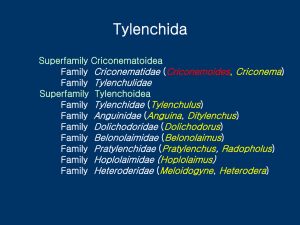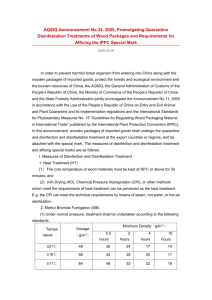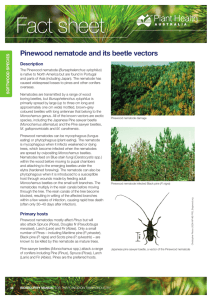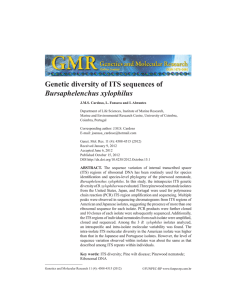Short communication Bursaphelenchus xylophlius Buhrer, 1934 (Nickle, 1970) in Spain Lee R
advertisement
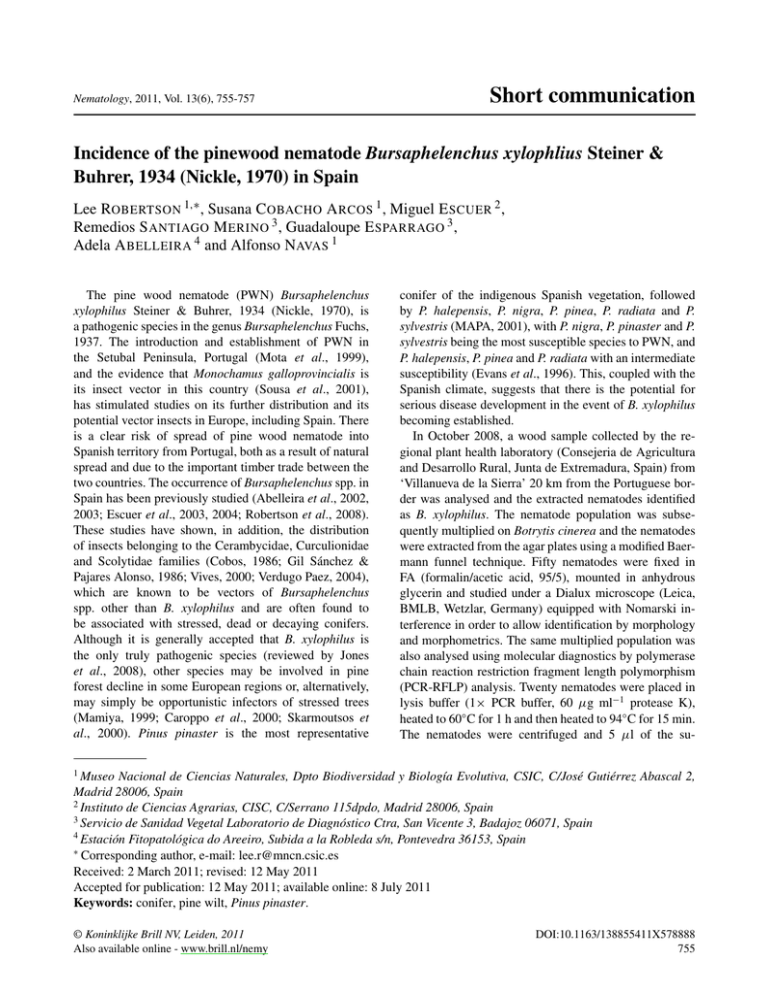
Nematology, 2011, Vol. 13(6), 755-757 Short communication Incidence of the pinewood nematode Bursaphelenchus xylophlius Steiner & Buhrer, 1934 (Nickle, 1970) in Spain Lee ROBERTSON 1,∗ , Susana C OBACHO A RCOS 1 , Miguel E SCUER 2 , Remedios S ANTIAGO M ERINO 3 , Guadaloupe E SPARRAGO 3 , Adela A BELLEIRA 4 and Alfonso NAVAS 1 The pine wood nematode (PWN) Bursaphelenchus xylophilus Steiner & Buhrer, 1934 (Nickle, 1970), is a pathogenic species in the genus Bursaphelenchus Fuchs, 1937. The introduction and establishment of PWN in the Setubal Peninsula, Portugal (Mota et al., 1999), and the evidence that Monochamus galloprovincialis is its insect vector in this country (Sousa et al., 2001), has stimulated studies on its further distribution and its potential vector insects in Europe, including Spain. There is a clear risk of spread of pine wood nematode into Spanish territory from Portugal, both as a result of natural spread and due to the important timber trade between the two countries. The occurrence of Bursaphelenchus spp. in Spain has been previously studied (Abelleira et al., 2002, 2003; Escuer et al., 2003, 2004; Robertson et al., 2008). These studies have shown, in addition, the distribution of insects belonging to the Cerambycidae, Curculionidae and Scolytidae families (Cobos, 1986; Gil Sánchez & Pajares Alonso, 1986; Vives, 2000; Verdugo Paez, 2004), which are known to be vectors of Bursaphelenchus spp. other than B. xylophilus and are often found to be associated with stressed, dead or decaying conifers. Although it is generally accepted that B. xylophilus is the only truly pathogenic species (reviewed by Jones et al., 2008), other species may be involved in pine forest decline in some European regions or, alternatively, may simply be opportunistic infectors of stressed trees (Mamiya, 1999; Caroppo et al., 2000; Skarmoutsos et al., 2000). Pinus pinaster is the most representative conifer of the indigenous Spanish vegetation, followed by P. halepensis, P. nigra, P. pinea, P. radiata and P. sylvestris (MAPA, 2001), with P. nigra, P. pinaster and P. sylvestris being the most susceptible species to PWN, and P. halepensis, P. pinea and P. radiata with an intermediate susceptibility (Evans et al., 1996). This, coupled with the Spanish climate, suggests that there is the potential for serious disease development in the event of B. xylophilus becoming established. In October 2008, a wood sample collected by the regional plant health laboratory (Consejeria de Agricultura and Desarrollo Rural, Junta de Extremadura, Spain) from ‘Villanueva de la Sierra’ 20 km from the Portuguese border was analysed and the extracted nematodes identified as B. xylophilus. The nematode population was subsequently multiplied on Botrytis cinerea and the nematodes were extracted from the agar plates using a modified Baermann funnel technique. Fifty nematodes were fixed in FA (formalin/acetic acid, 95/5), mounted in anhydrous glycerin and studied under a Dialux microscope (Leica, BMLB, Wetzlar, Germany) equipped with Nomarski interference in order to allow identification by morphology and morphometrics. The same multiplied population was also analysed using molecular diagnostics by polymerase chain reaction restriction fragment length polymorphism (PCR-RFLP) analysis. Twenty nematodes were placed in lysis buffer (1× PCR buffer, 60 μg ml−1 protease K), heated to 60◦ C for 1 h and then heated to 94◦ C for 15 min. The nematodes were centrifuged and 5 μl of the su- 1 Museo Nacional de Ciencias Naturales, Dpto Biodiversidad y Biología Evolutiva, CSIC, C/José Gutiérrez Abascal 2, Madrid 28006, Spain 2 Instituto de Ciencias Agrarias, CISC, C/Serrano 115dpdo, Madrid 28006, Spain 3 Servicio de Sanidad Vegetal Laboratorio de Diagnóstico Ctra, San Vicente 3, Badajoz 06071, Spain 4 Estación Fitopatológica do Areeiro, Subida a la Robleda s/n, Pontevedra 36153, Spain ∗ Corresponding author, e-mail: lee.r@mncn.csic.es Received: 2 March 2011; revised: 12 May 2011 Accepted for publication: 12 May 2011; available online: 8 July 2011 Keywords: conifer, pine wilt, Pinus pinaster. © Koninklijke Brill NV, Leiden, 2011 Also available online - www.brill.nl/nemy DOI:10.1163/138855411X578888 755 Short communication Fig. 1. Morphological characteristics of Bursaphelenchus xylophilus 197 from Extremadura, Spain. A: Female tail; B: Vulval flap; C: Male spicule. pernatant was used for PCR amplification. The forward primer 5 -CGTAACAAGGTAGCTGTAG-3 (Ferris et al., 1993) and reverse primer 5 -TTTCACTCGCCGTTACTA AGG-3 (Vrain, 1993) were used in reactions containing, 10 mm Tris-HCl (pH 8.3), 1.5 mm MgCl2 , 50 mm KCl, 200 mm each of dATP, dCTP, dGTP and dTTP and 1 unit of Taq DNA polymerase (Biotools B and M labs, Madrid, Spain). Initial denaturalisation was carried out for a period of 2 min at 94◦ C followed by 35 cycles of 94◦ C for 1 min, 55◦ C for 1 min, 72◦ C for 1 min and followed by a final 5-min extension period at 72◦ C. Amplified DNA fragments were digested with the restriction enzymes RsaI, HaeIII, MspI, HinfI and AluI (New England Biolabs, Massachusetts, MA, USA) following the manufacturer’s instructions and separated by a 2% agarose gel. This analysis was repeated three times. Digestion products were compared with previously published data for B. xylophilus and B. mucronatus (Hoyer et al., 1998). Based on morphological characters (Fig. 1) and molecular analysis (Fig. 2), the nematode population was confirmed to be B. xylophilus. Since 2008, preventative measures have been carried out based on an official contingency programme headed by the Spanish Ministry of Environmental Affairs in 756 Fig. 2. ITS-RFLP analysis of Bursaphelenchus xylophilus. M) 100-bp molecular markers. 1) ITSAmplicon, 2) RsaI, 3) HaeIII, 4) MspI, 5) HinfI, 6) AluI. agreement with the European Union. As a consequence of systematic sampling along the Portuguese border and national territory, B. xylophilus was found in Sierra de las Nieves (Lugo province in Galicia) in 2010, 10 km from the Portuguese border. This finding was officially reported to the European authorities. This last population was morphologically and molecularly identified as B. xylophilus following the EPPO protocols. In the future, Nematology Short communication molecular studies are planned to compare the Spanish outbreaks with intercepted material from Portugal. Vector studies are also planned given that M. galloprovincialis is also widely spread throughout Spain. References A BELLEIRA , A., E SCUER , M., M ANSILLA , J., A RIAS , M. & B ELLO , A. (2002). Survey of the pine wilt nematode and its vector insect in the autonomic community of Galicia. Nematology 4, 259. A BELLEIRA , A., E SCUER , M., A RIAS , M. & M ANSILLA , J. (2003). The genus Bursaphelenchus Fuchs (Nematoda: Aphelenchida) in north-west Spain. Nematology 5, 677-685. C AROPPO , S., C AVALLI , M., C ONIGLIO , D. & A MBRO GIONI , L. (2000). Pathogenicity studies with various Bursaphelenchus populations on conifer seedlings under controlled and open air conditions. Redia 83, 61-75. C OBOS , J.M. (1986). Fauna Ibérica de Coleópteros Buprestidae. Madrid, Spain, CSIC, 364 pp. E SCUER , M., A RIAS , M. & B ELLO , A. (2003). The genus Bursaphelenchus (Nematoda) in Spain. In: Mota, M. & Vieira, P. (Eds). The pine wood nematode, Bursaphelenchus xylophilus. Nematology monographs and perspectives 1. Leiden, The Netherlands, Brill Academic Publishers, pp. 9399. E SCUER , M., A RIAS , M. & B ELLO , A. (2004). Occurrence of the genus Bursaphelenchus Fuchs, 1937 (Nematoda: Aphelenchida) in the Spanish conifer forests. Nematology 6, 155156. E VANS , H.F., M C NAMARA , D.G., B RAASCH , H., C HA DOEUF, J. & M AGNUSON , C. (1996). Pest risk analysis (PRA) for the territories of the European Union (as PRA area) on Bursaphelenchus xylophilus and its vectors in the genus Monochamus. EPPO Bulletin 26, 199-249. F ERRIS , V.R., F ERRIS , J.M. & FAGHIHI , J. (1993). Variation in spacer ribosomal DNA in some cyst forming species of plant parasitic nematodes. Fundamental and Applied Nematology 16, 177-184. G IL S ÁNCHEZ , L.A. & PAJARES A LONSO , J.A. (1986). Los escolítidos de las coníferas en la Península Ibérica. Madrid, Spain, Monografias INIA 53, 194 pp. H OYER , U., B URGERMEISTER , W. & B RAASCH , H. (1998). Identification of Bursaphelenchus species (Nematoda, Aphelenchoididae) on the basis of amplified ribosomal DNA (ITS- Vol. 13(6), 2011 RFLP). Nachrichtenblatt des Deutschen Pflanzenschutzdiensts 50, 273-277. J ONES , J.T., M OENS , M., M OTA , M., L I , H. & K IKUCHI , T. (2008). Bursaphelenchus xylophilus: opportunities in comparative genomics and molecular host-parasite interactions. Molecular Plant Pathology 9, 357-368. M AMIYA , Y. (1999). Review on the pathogenicity of Bursaphelenchus mucronatus. In: Futai, K., Togashi, K. & Shokado, I.T. (Eds). Sustainability of pine forest in relation to pine wilt and decline. Proceedings of the Symposium, Tokyo, Japan, 26-30 October 1998. Kyoto, Japan, Shokado Shoten, pp. 4751. MAPA (2001). Anuario de estadística agroalimentaria 2000. Ministerio de Agricultura Pesca y Alimentación, Madrid, Spain, 691 pp. M OTA , M.M., B RAASCH , H., B RAVO , M.A., P ENAS , A.C., B URGERMEISTER , W., M ETGE , K. & S OUSA , E. (1999). First report of Bursaphelenchus xylophilus in Portugal and in Europe. Nematology 1, 727-734. ROBERTSON , L., G ARCIA -A LVAREZ , A., A RCOS , S.C., D IEZ -ROJO , M.A., M ANSILLA , J.P., S ANZ , R., M AR TINEZ , C., E SCUER , M., C ASTRESANA , L., N OTARIO , A. ET AL. (2008). Potential insect vectors of Bursaphelenchus spp. (Nematoda: Parasitaphelenchidae) in Spanish pine forests. In: Mota, M.M. & Vieira, P. (Eds). Pine wilt disease: a worldwide threat to forest ecosystems. Dordrecht, The Netherlands, Springer, pp. 221-233. S KARMOUTSOS , H., S KARMOUTSOS , G. & M ICHALOPOU LOS -S KARMOUTSOS , H. (2000). Pathogenicity of Bursaphelenchus sexdentati, Bursaphelenchus leoni and Bursaphelenchus hellenicus on European pine seddlings. Forest Pathology 30, 149-156. S OUSA , E., B RAVO , M.A., P IRES , J., NAVES , P., P ENAS , A.C., B ONIFACIO , L. & M OTA , M.M. (2001). Bursaphelenchus xylophilus (Nematoda: Aphelenchoididae) associates with Monochamus galloprovincialis (Coleoptera: Cerambycidae) in Portugal. Nematology 3, 89-91. V ERDUGO PÁEZ , A. (2004). Monografías de la socieda Andaluza de Entomología (SAE). 1. Cerambicidae de Andalucía. Diputación de Córdoba, 152 pp. V IVES , E. (2000). Fauna Ibérica. 12 Coleoptera Cerambycidae. Museo Nacional de Madrid, Spain, Ciencias Naturales, CSIC, 715 pp. V RAIN , T.C. (1993). Restriction fragment length polymorphism separates species of the Xiphinema americanum group. Journal of Nematology 25, 361-364. 757
